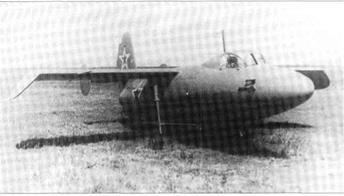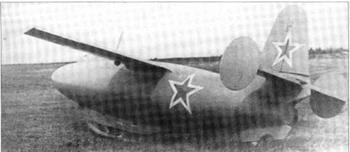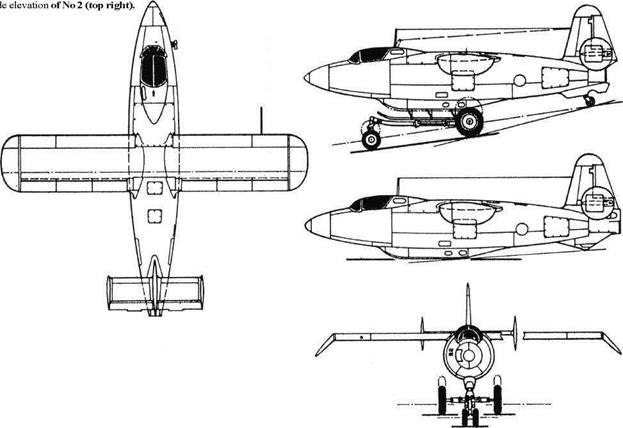Florov 4302
Purpose: Rocket-propelled aircraft for aerodynamic research.
Design Bureau: Ilya Florentyevich Florov (1908-83) had a long career at several OKBs and State organizations, some of his products being biplane fighters designed with A A Borovkov. In 1943 he headed a design cell in NIl-WS (air force state test institute).
In 1943 Florov was assigned the task of creating a small rocket-engined aircraft to test wing profiles, flight-control systems and other features. At this time published German papers on swept wings (1935) had not been studied. Three examples of No 4302 were funded, and Nil pilots A F Pakhomov and I F Yakubov were assigned to the programme. The No 1 aircraft was not fitted with an engine, and made 46 flights from late 1946, on each occasion being towed to about 5,000m (16,400ft) by a Tu-2. The No 2 was flown under power, the first take-off (by Pakhomov) being in August 1947. In the same month the programme was terminated, funds being transferred to the MiG I-270. At this time the No 3 aircraft had for some time been complete but waiting for its RD-2M-3 engine.
The 4302 was a small aircraft with a fuselage dictated by the size of cockpit and pro
pellant tanks. Construction was entirely light – alloy stressed skin, with a very good surface finish. The untapered wings had a 13-per-cent laminar CAHI (TsAGI) profile devised by G P Svishchev. They were made as one unit attached above the fuselage, with down – turned tips. On each trailing edge were three sections of slotted flap which were also operated in opposition for lateral control. The tail comprised a fixed fin and tailplane, with fixed endplate fins, and manually driven rudder and elevators with inset hinges and mass balances. The pilot had a small pressurized cockpit in the nose with an upward-hinged canopy. The No 1 aircraft was completed with conventional fixed landing gear (using some La-5FN parts), for slow-speed glider flights. The Nos 2 and 3 were designed to take off from a tricycle-gear trolley and land on a centreline skid and tailwheel. The No 2 was fitted with a liquid rocket by A M Isayev assisted by L S Dushkin rated at 1,100kg (2,425 Ib) at sea level. In the rear fuselage was a large tank for red fuming nitric acid made of 3mm Enerzh 18-8 stainless, wrapped with OVS wire to withstand gas feed pressure. Behind was the tank ofpetrol (gasoline). Later, in 1947 a more powerful 1,140kg (2,513 Ib) Dushkin engine was fitted. The No 3 aircraft was to have been
fitted with an RD-2M-3 engine developed by Dushkin and V P Glushko, with main and cruise chambers with sea-level ratings of 1,450 and 400kg (3,197 and 882 Ib). In this condition it was to have been designated No 4303. One report says that an RD-2M or RD – 2M-3 was retrofitted to No 2, but there is no record of it flying with this engine.
These aircraft appear to have left no record of aerodynamic achievement.
|
Dimensions Span (all) Length (No 2) (No 3) Wing area (all) |
6.932m 7.124m 7.152m 8.85 nf |
22 ft 9 in 23 a VA in 23 ft 5% in 95.26ft2 |
|
Weights |
||
|
Empty (No 1) |
970kg |
2,138 Ib |
|
Loaded (No1) |
1,350kg |
2,976 Ib |
|
(No 3) |
1,750kg |
3,859 Ib |
|
Performance |
||
|
Max speed (No2, achieved) 826km/h |
513 mph |
|
|
Landing speed (all) |
125km/h |
78 mph |
|

|
 Above right: 4302 No 2 in take-off configuration.
Above right: 4302 No 2 in take-off configuration.
Left: 4302 No 2 after landing.












